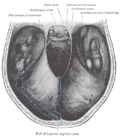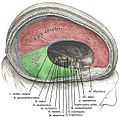Cerebellar tentorium
Cerebellar Tentorium[edit]
The cerebellar tentorium, also known as the tentorium cerebelli, is a structure within the brain that plays a crucial role in supporting and protecting the cerebellum. It is a crescent-shaped fold of dura mater, a tough and fibrous membrane that surrounds the brain.
Anatomy[edit]
The cerebellar tentorium is located in the posterior cranial fossa, which is the space at the back of the skull that houses the cerebellum. It separates the cerebellum from the occipital lobes of the cerebral cortex. The tentorium is attached to the petrous part of the temporal bone, the occipital bone, and the posterior clinoid processes.
The structure of the cerebellar tentorium resembles a tent, with its apex pointing towards the internal occipital protuberance and its base attached to the petrous part of the temporal bone. It forms a horizontal shelf that partially separates the cerebellum from the cerebral hemispheres.
Function[edit]
The primary function of the cerebellar tentorium is to provide structural support and protection to the cerebellum. It acts as a barrier, preventing the cerebellum from compressing against the occipital lobes during sudden movements or changes in intracranial pressure.
Additionally, the tentorium cerebelli plays a role in maintaining the position of the cerebellum within the posterior cranial fossa. It helps to anchor the cerebellum in place and prevents it from shifting or displacing during head movements.
Clinical Significance[edit]
In certain medical conditions, the cerebellar tentorium can become compromised, leading to various clinical manifestations. For example, a tentorial herniation can occur when increased pressure within the skull causes the cerebellum to herniate through the tentorial opening. This can result in neurological symptoms such as headache, altered consciousness, and focal neurological deficits.
References[edit]
<references />
See Also[edit]
-
Cerebellar tentorium illustration
-
Gray's Anatomy illustration of the tentorium
-
Falx cerebri and tentorium cerebelli
-
Sobo 1909 illustration of the tentorium
-
Gray's Anatomy illustration of the brain
-
Human brain dura mater reflections
-
Tentorium cerebelli
Ad. Transform your life with W8MD's Budget GLP-1 injections from $75


W8MD offers a medical weight loss program to lose weight in Philadelphia. Our physician-supervised medical weight loss provides:
- Weight loss injections in NYC (generic and brand names):
- Zepbound / Mounjaro, Wegovy / Ozempic, Saxenda
- Most insurances accepted or discounted self-pay rates. We will obtain insurance prior authorizations if needed.
- Generic GLP1 weight loss injections from $75 for the starting dose.
- Also offer prescription weight loss medications including Phentermine, Qsymia, Diethylpropion, Contrave etc.
NYC weight loss doctor appointmentsNYC weight loss doctor appointments
Start your NYC weight loss journey today at our NYC medical weight loss and Philadelphia medical weight loss clinics.
- Call 718-946-5500 to lose weight in NYC or for medical weight loss in Philadelphia 215-676-2334.
- Tags:NYC medical weight loss, Philadelphia lose weight Zepbound NYC, Budget GLP1 weight loss injections, Wegovy Philadelphia, Wegovy NYC, Philadelphia medical weight loss, Brookly weight loss and Wegovy NYC
|
WikiMD's Wellness Encyclopedia |
| Let Food Be Thy Medicine Medicine Thy Food - Hippocrates |
Medical Disclaimer: WikiMD is not a substitute for professional medical advice. The information on WikiMD is provided as an information resource only, may be incorrect, outdated or misleading, and is not to be used or relied on for any diagnostic or treatment purposes. Please consult your health care provider before making any healthcare decisions or for guidance about a specific medical condition. WikiMD expressly disclaims responsibility, and shall have no liability, for any damages, loss, injury, or liability whatsoever suffered as a result of your reliance on the information contained in this site. By visiting this site you agree to the foregoing terms and conditions, which may from time to time be changed or supplemented by WikiMD. If you do not agree to the foregoing terms and conditions, you should not enter or use this site. See full disclaimer.
Credits:Most images are courtesy of Wikimedia commons, and templates, categories Wikipedia, licensed under CC BY SA or similar.
Translate this page: - East Asian
中文,
日本,
한국어,
South Asian
हिन्दी,
தமிழ்,
తెలుగు,
Urdu,
ಕನ್ನಡ,
Southeast Asian
Indonesian,
Vietnamese,
Thai,
မြန်မာဘာသာ,
বাংলা
European
español,
Deutsch,
français,
Greek,
português do Brasil,
polski,
română,
русский,
Nederlands,
norsk,
svenska,
suomi,
Italian
Middle Eastern & African
عربى,
Turkish,
Persian,
Hebrew,
Afrikaans,
isiZulu,
Kiswahili,
Other
Bulgarian,
Hungarian,
Czech,
Swedish,
മലയാളം,
मराठी,
ਪੰਜਾਬੀ,
ગુજરાતી,
Portuguese,
Ukrainian






